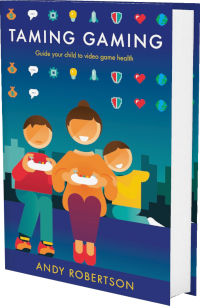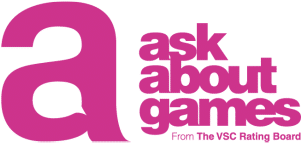 Android
Android iOS
iOS Mac
Mac Switch
Switch Wii
Wii Wii U
Wii U PC
PC PS4
PS4 PS5
PS5 Xbox One
Xbox One Xbox X|S
Xbox X|S25/08/2021 16:40:44 2 years ago Author: Andy Robertson
Like most ways to play, video games are fun on your own, but much more fun with other people. Online video games are a positive and connecting way to play. However, as children move into this space it can be hard to know how to protect, support and guide them.
Before I get into advice about how to understand and control who they are talking to and playing within their games, the most important piece of advice is to foster an open conversation about online friends with your child. It’s crucial that they can talk to you about who they are playing with and what’s happening without worrying about losing the games they love to play.
A powerful way to do this is to play online games with your child from an early age. This creates a context where mistakes are made together and establishes an open conversation where your child is more likely to tell you if something happens online that doesn't feel right, and more likely to listen to your ongoing advice and guidance. I’ve put together this list of games that are great to take first steps into this online playground with your child.
Discord, Facebook And Game-Adjacent Groups
This open context should include game-adjacent communities. These are ways that children communicate with each other (and adults) to learn about games, chat and organise teams to play games.Discord is the most popular currently, but some communities also use Facebook pages, Messenger or WhatsApp. These communication platforms are not designed for children and you need to be at least 13 to legally use most of them. The groups are often private to ensure that only fans of the game can join.
These apps may have some settings to specify what information is shared, but there are no passwords to lock these in place like they are on systems designed with children in mind (like video game consoles).
These groups can extend the enjoyment and develop deeper tactics and team-play in games. My son loves his Battlefront and Dungeons and Dragons Discord groups where he organises a team of players to meet on Xbox and play more organised battles that would otherwise be possible.
It’s a layer of interaction that reminds me of the coordinated re-enactment societies that meet to recreate historic battles. But also, it’s something I work to keep part of my conversations with him because I know he (13) is talking to a range of ages of people, many of whom are likely adults.
Using these platforms yourself so you understand how they work is a good step. A good first step can be to create a family community on Discord, Facebook or WhatsApp. You can have fun getting to know how it works and children can gain confidence in asking questions.
Making an informed decision about whether your child should be using them is important. It’s fine to say “no” or “not yet” if they are not mature enough to understand risks. When they are using them, ensure you talk about those communities, check-in (with permission) at what is being shared.]
Friends on Xbox
On the Xbox, you have a list of friends. These are the people you want to interact with through party chat and messaging. Forming a party with your friends and muting other players is a good way to avoid speaking to strangers. When someone adds you as a friend they are listed as Followers until you accept them as a Friend.Who Are They Friends With?
You can view your child’s friends and messages via the Xbox they use to play, at the bottom of the Xbox Account web page, the Xbox smartphone app or Xbox Windows app. (This is different from the Xbox Family app that is used to adjust your child’s account settings.)
With permission from your child, installing the Xbox app is a good way to stay on top of friend requests and communication from other players.
How Are Friends Added?
Friends can be added by a child knowing their GamerTag in real life. Xbox also makes suggestions of new friends from people they have played with recently, or who recently started following you.
What Limits Can I Apply?
You can remove friends by selecting them in the Friends List, selecting More and then changing their status. You can also Block a person by selecting More and then Block.
You can limit who can see your child on the Xbox via the Privacy & Online Safety area of their account accessed on the Xbox, web or Xbox Family Settings app. This enables you to control:
- Whether they can add friends
- Who can see your child’s Xbox profile
- Who can see you child’s Xbox friends
- Who can see your child’s real name
Friends on PlayStation
On PlayStation, you have a list of friends who can see when you are online. You can see what they are playing and they can see what you are playing. Forming a party with your friends and muting other players is a good way to avoid speaking to strangers.Who Are They Friends With?
You can view your child’s friends on the PlayStation console they use or by installing the PlayStation App and logging into with permission from your child. This is a good way to see their current friends, requests and messages.
How Are Friends Added?
Friends can be added if you know their PlayStation ID in real life. You can also add friends by searching for them using their real name. (Child accounts cannot be used to send or receive real-name requests.) You can add players from the Players Met list which are people you have recently played in an online game. You can also view profiles of players in online games to see their PlayStation ID and send a request after playing.
What Limits Can I Apply?
To remove a friend or friend request, highlight the player request in the friends list and select Delete friend or friend request. You can also Block a person by highlighting them and pressing the Option button on the controller. Pressing the Option button on the messages screen enables you to report inappropriate messages.
You can limit who can see your child on the PlayStation via the Privacy Settings of their account accessed on the PlayStation or web page. This enables you to control:
- Who can see your child’s Friends list.
- Who can send your child Friend requests.
- Who can see your child’s real name and whether it appears in games.
- Who can invite your child to online games and groups.
Friends on Nintendo
On Nintendo Switch you have a list of friends who can see when you are online. You can see what they are playing and they can see what you are playing. You view your list of friends by selecting your User icon on the Switch Home Screen and opting for Friend List. Your code is displayed here and is 12 numbers and 2 letters.Who Are They Friends With?
You can view your child’s friends only on the Switch console. Select their User Icon in the Home Menu on the Switch then go to Friends List.
How Are Friends Added?
You can add people if you know their Friend Code in real life. You can also add friends if you have played with people in online games, or have connected with them in Wii U, Nintendo 3DS, Facebook, or Twitter. You must link your user account to a Nintendo Account prior to sending or receiving friend requests.
What Limits Can I Apply?
You can limit who can see the games you are playing by selecting your User Icon in the Home Menu on the Switch. Select User Settings and then you can control:
- Who can see what your child is playing
- Whether they can receive friend requests
Friends on Roblox
On Robox you can send chat messages (outside of games) to people who have accepted your Friend request. Being friends grants access to the profile of other players in the game.However, in-game messages can be sent to anyone regardless of whether they are friends in the game or not. You can control who can send chat messages and whether your child can receive in-game messages in your account settings.
Who Are They Friends With?
You can view your child’s friends on Roblox by logging into their account at Roblox.com and clicking See All next to the Friends tab.
How Are Friends Added?
If you already know someone's username you can search for them to find their home page then click the Add Friend button. You can also add people as friends after playing a game with them, or by browsing other people’s friend's list and clicking the Add Friend button.
What Limits Can I Apply?
Although you can’t stop other players from making Friend requests, you can ignore them. You can remove friends by clicking the Unfriend button on that person’s profile.
Roblox has very robust filters on chat. For players 12 and under it's stricter and they can't even use numbers. For players 13 and over it's still very strict and they can use numbers. The majority of inappropriate words are filtered and monitored. For instance, phrases like "s3xy" or "b00bs" will be stopped.
You can control how players interact, friend and message your child in the My Settings area of the Roblox.com website. Select the Privacy section then specify:
- Who can chat message your child
- Who can start a chat with your child
- Who can invite your child to private games
- Whether your child can be messaged in-game or not.
Friends on Minecraft
Whether other players are friends or not of your child they can send messages in various ways once they are playing in the same game. This depends on the settings of the device they use to play the game and the settings configured by the person who's online world they are playing in.The chat in Minecraft is different on the Bedrock Edition and the Java Edition. Java edition is only for PC, while Bedrock edition is on consoles, mobile devices, and Windows 10 and above.
In Bedrock addition swear words and inappropriate language sent via realms chat, server chat, signs, book and quills will be censored. It's worth noting that players can still chat on the console directly (as described above). PlayStation players can send and receive messages via PSN. Other platforms will require you to have an Xbox Live account which you can also use to send and receive messages.
Here are the ways you can chat in Minecraft:
- Realms Chat - Realms are personal multiplayer servers that are hosted by Mojang. While in a Realm server anybody in the server can send and see messages via the chat system.
- Server Chat - Servers are personal multiplayer servers that aren’t hosted or moderated by Mojang. Multiplayer servers have also have a chat system for players to send and view messages.
- Signs - Players can use signs, which are in game items, to display text. Four lines of text can be used to communicate on signs.
- Book and Quill - Another in-game item that can be used to communicate or write the text down for later.
© 2024 Family Gaming Database












